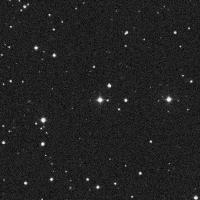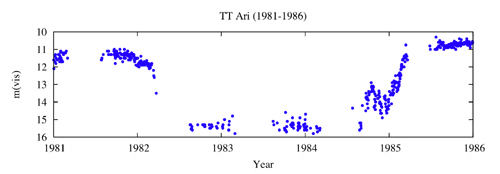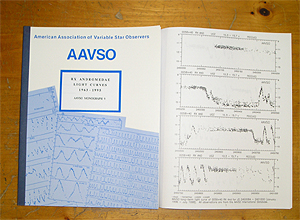Prepared by Dr. Matthew Templeton - October 2007
RX And — a CV in transition?
The final months of the year bring one of the more remarkable cataclysmic variables back into evening view for Northern observers. Nearly every CV -- dwarf novae, nova-likes, and AM Her stars -- has something unique to say with its light curve. But this Variable Star of the Season -- RX Andromedae -- is truly remarkable. Since its discovery in 1905, RX And has undergone nearly every type of behavior seen in the dwarf novae, creating one of the more interesting light curves among the CVs. In 2002, Matthias Schreiber, Boris Gänsicke, and Janet Mattei published a phenomenological study of RX And's remarkable behavior, and came to the conclusion that it is a previously unrecognized transitional object -- not merely a Z Cam star but a member of the VY Scl class as well. Their analysis helped to answer the question of why the VY Scl stars exhibit their deep minima, and also gave clues as to how CVs in general evolve over time. We hope you take the opportunity to get to know this particular star -- it's really something to see.
Discovery and History
 A DSSII (blue) image of RX Andromedae
A DSSII (blue) image of RX Andromedae
(DSSII image copyright: Caltech)
RX Andromedae was discovered by the British astronomer A. Stanley Williams in 1905, and although it was first incorrectly classified as a long-period Cepheid, it was noted to have similarities to the then mysterious object SS Cygni, now known to be one of the dwarf novae. RX Andromedae was eventually recognized as one of the U Geminorum variables, and subsequently placed in the subclass of objects known as Z Camelopardalis stars, marked by the irregular occurrence of standstills in the light curve. During these standstills, the Z Cam stars remain at a high brightness level for lengths of time that can vary from days to years.
It is very interesting to read the discussion of these objects in (for example) Payne-Gaposchkin & Gaposchkin's Variable Stars, published in the 1930's. Very little was understood about why the "SS Cygni variables" behaved the way they did, and although there was much speculation about why they varied, fundamental astrophysical understanding simply hadn't come far enough at that point to yield an answer. Even in the late 19th Century, SS Cygni and U Geminorum were known to have emission lines of hydrogen and calcium at minimum, and absorption lines at maximum; spectroscopy of RX And in the 1930's and 1940's showed the same thing. This is one piece of evidence that perhaps the source of light transitions from an optically thin emitter to an optically thick one during outbursts. The final pieces of the observational puzzle wouldn't yet be available until these objects were discovered to be X-ray and ultraviolet emitters, and until very high time-resolved photometry and spectroscopy became possible. It wasn't even known until the 1950's (and the work of Crawford & Kraft) that the secondary stars in dwarf novae were overflowing their Roche lobes and transferring mass to the primary star.
Even as late as the 1990's the final details of why the dwarf novae went into outburst were still being hashed out by observers and theorists in the field. Although it was by then known they were binary stars in which a white dwarf accreted matter from a dwarf secondary star, the outburst mechanism wasn't yet proven. And even at that late date, RX Andromedae was still held up as a prototypical example of the Z Cam class (see France Cordova's review of Cataclysmic Variables in X-Ray Binaries for example). It wasn't really until astronomers took a long, hard look at the light curve itself that RX Andromedae revealed its true nature.
Z Cam stars and high-accretion rate systems: life above the period gap
 An artists' conception of a dwarf nova system. Matter is transferred from the secondary -- a main-sequence dwarf star -- to the white dwarf primary, forming an accretion disk. In this case, star spots on the secondary may enter the spilling point where matter falls off the secondary, temporarily quenching the mass transfer. (Image credit: A. Beardmore, University of Leicester, UK)
An artists' conception of a dwarf nova system. Matter is transferred from the secondary -- a main-sequence dwarf star -- to the white dwarf primary, forming an accretion disk. In this case, star spots on the secondary may enter the spilling point where matter falls off the secondary, temporarily quenching the mass transfer. (Image credit: A. Beardmore, University of Leicester, UK)
The physics of dwarf nova outbursts came to be understood in the early 1990s, and are now known to be caused by instabilities in the accretion disk. If the temperature in the disk reaches a certain threshold, it transitions from being optically thin to optically thick, and dramatically increases in temperature. This is what causes the disk to become very bright until such time as it can slowly cool down to the point where it becomes optically thin again. The Z Cam subclass dwarf novae are now known to be high accretion rate systems, in which the accretion disk can occasionally be locked into its bright outburst state until such time as it can transition back down to a more normal cycle of quiescence and outbursts; the mass accretion rate is so high that the disk sometimes gets stuck in a state where it can't cool off, become optically thin again, and return to quiescence. The high accretion rate systems are mainly limited to those with orbital periods larger than the period gap (between 2 and 3 hours), and are believed to be relatively young CVs whose orbits haven't evolved much since the formation of the white dwarf primary.
 One-day averages of visual observations of Z Cam, 1985-1989. The long stand-stills are hallmarks of the Z Cam class of dwarf novae, and indicate times when the disk is stuck in a bright state.
One-day averages of visual observations of Z Cam, 1985-1989. The long stand-stills are hallmarks of the Z Cam class of dwarf novae, and indicate times when the disk is stuck in a bright state.
Z Cam stars aren't the only high accretion rate CVs, though. The other two main types are the VY Sculptoris stars and the novalike variables. VY Sculptoris stars (like TT Ari, for example) are marked by alternating bright and faint standstills, while the novalikes remain in a permanent bright state. VY Scl was itself first thought to be a Z Cam type star because it, too, had very long standstills. In fact, it is more similar to the other novalike variables which stay in a permanent high state without exhibiting typical dwarf nova outbursts. But unlike the novalikes, VY Scl stars also exhibit very faint quiescent standstills, which can also last for very long periods of time. The standstills are believed to be caused by temporary reductions in the mass transfer rate, as well as the high temperature of the white dwarf primary. Although the mass accretion rate is generally high in VY Scl stars, it is thought that magnetic activity on the secondary star can temporarily halt mass transfer. Because the white dwarf is very hot, it keeps the inner accretion disk hot, allowing the disk to drain more completely than in other dwarf novae in the absence of mass transfer. When the disk disappears, the system enters its low state, and remains there until mass transfer resumes and the disk re-establishes itself.
 One-day averages of visual observations of TT Ari, 1981-1986. TT Ari is a VY Scl-type star, and also an intermediate polar. The long, faint interval is a hallmark of the VY Scl class, and the fact that it occurs both in magnetic and non-magnetic CVs means whatever causes the faint intervals cannot be in the disk -- magnetic CVs don't have them! The VY Scl-type fadings are now believed to be caused by variations in mass transfer from the secondary to the white dwarf.
One-day averages of visual observations of TT Ari, 1981-1986. TT Ari is a VY Scl-type star, and also an intermediate polar. The long, faint interval is a hallmark of the VY Scl class, and the fact that it occurs both in magnetic and non-magnetic CVs means whatever causes the faint intervals cannot be in the disk -- magnetic CVs don't have them! The VY Scl-type fadings are now believed to be caused by variations in mass transfer from the secondary to the white dwarf.
All of the high accretion-rate systems are believed to be young CVs. As these systems get older, the primary and secondary stars spiral in towards one another due to magnetic braking. Eventually, they reach a period minimum, and then start to move apart again due to gravitational radiation, by which point the secondary has been greatly reduced in mass. So it appears that the novalikes, the Z Cam stars, and the VY Scl stars are all freshly minted cataclysmics. The question then becomes this: is there evolution between one type and another, or are there fundamental differences among the various classes?
RX Andromedae: the light curve tells the story
The classification of RX And as a Z Cam-type dwarf nova wasn't controversial, because the most pronounced features of its light curve were the occasional standstills seen in every other Z Cam star. But RX And also exhibited some behaviors not seen in other Z Cam stars. For one, RX And has a higher amplitude than most Z Cam stars (nearly six magnitudes, as opposed to 2.5-3). For another, RX And occasionally enters low states where the star stops outbursting entirely, and fades to about a magnitude below the normal minimum -- just as the VY Scl stars do.
 The Hubble Space Telescope in orbit. Multiwavelength observations of dwarf novae -- particularly those made from space-based observatories -- have been key to understanding the physics of these objects. (Image credit: NASA)
The Hubble Space Telescope in orbit. Multiwavelength observations of dwarf novae -- particularly those made from space-based observatories -- have been key to understanding the physics of these objects. (Image credit: NASA)
One piece of evidence for the mixed classification of RX And came from detailed spectroscopy with the Hubble Space Telescope by Ed Sion, Paula Szkody, Boris Gänsicke, and collaborators in the late 1990s. Observations of the system during quiescence and outburst showed that the temperature of the white dwarf was very high at 34000 K, among the hottest of white dwarf primaries. The fact that the white dwarf is so hot suggests it could in principle take after the VY Scl stars, if the mass transfer rate were variable enough. But the real key to understanding the system came from simply examining the light curve itself.
RX Andromedae has a long and well-observed light curve in the AAVSO archives, with near continuous coverage throughout the 20th Century. Early on, the behavior matches that of a fairly normal Z Cam star. But as time went on, the system began to exhibit the long faint states typical of the VY Scl stars (even before VY Scl was itself identified as a unique class of object in the 1960's-1970's). Schreiber, Gänsicke, and Mattei published a short letter in Astronomy & Astrophysics in 2002, describing the light curve and showing examples of the long quiescent standstills exhibited by RX And (including those around JD 2443500 and 2450400). In their paper, they also note that this kind of behavior is seen in other kinds of systems including those with magnetic white dwarfs like AM Her. This is important because it says the deep fadings cannot be due simply to something happening to the accretion disk -- because the AM Her stars don't have them! AM Her stars funnel the accretion stream directly along their magnetic field lines onto the white dwarf, so the fact that the quiescent fadings are seen in magnetic CVs, too, means that something is happening to the mass transfer at the source, namely the surface of the secondary. The exact cause isn't known, but one plausible explanation is magnetic activity or star spots on the secondary star. If a spot passes through the Lagrange point where mass is transferred from the secondary to the primary, it may prevent matter from flowing off of the secondary, like "turning off the tap" temporarily.
One-day averages of visual observations of RX Andromedae, 1995-1998. Note the alternation between Z Cam-like bright standstills and outbursts and VY Scl-like faint standstills. This particular interval of time was key to understanding the transitional nature of RX And.
The reason why the Schreiber, Gänsicke, & Mattei paper is so interesting is because it seems to prove that RX And is a transitional object. Prior to this work, it had been argued that because there were no Z Cam stars seen with large variations in mass transfer, there couldn't be evolution between the Z Cam stars and the VY Scl stars. Furthermore, the phenomenology of the two were so different, it seemed that something else distinguished the two classes. Z Cams take after the classical dwarf novae, and VY Scls are more novalike in behavior. But it seems clear from the behavior of RX And that it does indeed show large mass transfer variations, and straddles the boundary between the two classes. As Schreiber, Gänsicke, & Mattei say in their paper:
...the answer to the question... "And why is there no transitional object between a [Z Cam] and a [VY Scl]?" is: such objects do exist! Moreover, one has to conclude that Z Cam and VY Scl stars are obviously not distinctly different systems although dwarf nova outbursts have a different physical origin (disc instabilities) than the typical VY Scl variability (strong mass transfer variations). One is prone to speculate whether Z Cam stars do in fact evolve into VY Scl systems, and whether RX And with its orbital period of 5.04 hr is just at the beginning of this metamorphosis.
The light curve tells the story! RX Andromedae was the variable star of Monograph 9 and its supplement of the AAVSO Monograph Series.
Observing RX Andromedae
RX And is well-placed for observers in the northern hemisphere, and can (in principle) be observed year-round for observers at high northern latitudes. When it is in its Z Cam-like state, it goes into outburst every 14 days or so on average, although it also exhibits both high and low standstills at random times and with random durations. RX And was recently in AAVSO news as one of the targets of the monitoring campaign of Alert Notice 345. But as an object with a well-observed (and well-studied!) light curve, continued observations are important to keep the record of RX And's behavior up-to-date. The paper by Schreiber, Gänsicke, & Mattei was based entirely on visual magnitude estimates, and continued visual monitoring is crucial. Using the Variable Star Plotter (VSP) you can create charts of all scales for use in making visual or CCD observations.
The recent light curve of RX And shows that it was probably in a short Z Cam standstill during the last annual gap, and it may be entering another bright standstill again after a few months of normal dwarf nova outbursts. The last major quiescent standstill occurred all the way back in November 1996 (around JD 2450400), although there was a short one in June 2000 (2451700), and some reduced activity around May 2005 (2453500). Because RX And exhibits such a wide range of behavior, it's important to keep track of what it's doing, particularly around the times when the Sun interferes. We encourage all AAVSO observers -- visual and instrumental -- to add RX Andromedae to your list of stars to watch. Given all of the odd behavior it shows, you might see something extraordinary when you look!
For More Information
- The recent light curve of RX And
- VSP charts for RX And
- Alert Notices 232 and 235 on the 1996 deep minimum
- Mattei, J.A., Waagen, E.O., Oppenheimer, B.D., & Foster, E.G., 1996, AAVSO Monograph 9: RX Andromedae 1963-1995
- Mattei, J.A., Malatesta, K.H., and Waagen, E.O., 2002 AAVSO Monograph 9, Supplement 1: RX Andromedae light curves 1996-2000
- Hellier, C., 2001, Cataclysmic Variable Stars: How And Why They Vary (Chichester, UK: Springer-Praxis)
- Sion, E. et al., 2001, "Hubble Space Telescope Spectroscopy of the Dwarf Nova RX Andromedae. I. The Underlying White Dwarf", Astrophysical Journal 555, 834
- Sion, E. et al., 2000, "The Rotation Rate and the Surface Temperature of the Hot, Accreting White Dwarf in the Dwarf Nova RX Andromadae", JAAVSO 29, 1
- Sepinsky, J. et al., 2002, "Hubble Space Telescope Spectroscopy of the Dwarf Nova RX Andromedae during Outburst Rise and Decline", Astrophysical Journal 574, 937
- Schreiber, M.R.,Gänsicke, B.T., & Mattei, J.A., 2002, " RX And: An intermediate between Z Cam and VY Scl stars", Astronomy & Astrophysics 384, L6
- Warner, B., 1995, Cataclysmic Variable Stars (Cambridge: Cambridge U. Press)



